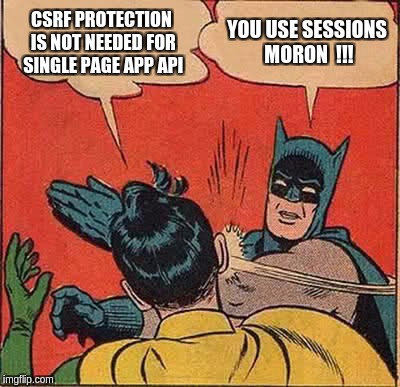CSRF protection on single page app API
Article
Let’s first define our terms:
We are talking about Single Page apps as applications that will render one page with JavaScript Framework (like Angular.js) and do all remaining communication with backend via API requests (e.g. JSON API build in Ruby on Rails, Elixir Phoenix)
CSRF attack protection as protection against 3rd party forcing users browser to send requests to a server where your user is authenticated with an active session. Let me quote example from Ruby on Rails security guideline
Bob is sign in to a website
www.webapp.comvia browser session/cookie.Bob browses a message board and views a post from a hacker where there is a crafted HTML image element. The element references a command in Bob’s project management application, rather than an image file:
Bob’s session at www.webapp.com is still alive, because he didn’t log out a few minutes ago.
By viewing the post, the browser finds an image tag. It tries to load the suspected image from www.webapp.com. As explained before, it will also send along the cookie with the valid session ID.
The web application at www.webapp.com verifies the user information in the corresponding session hash and destroys the project with the ID 1. It then returns a result page which is an unexpected result for the browser, so it will not display the image.
Bob doesn’t notice the attack - but a few days later he finds out that project number one is gone.
Now yes this example uses GET request for delete action but as is explained further down in the guideline link it’s possible to make malicious website send POST or DELETE request this way. The point is that it’s easy to make users browser trigger malicious actions event without session hijacking (stealing session, cookie).
Usually you see CSRF attack protection mentioned in context of
“submitting forms from static website”. I was recently reading more on CSRF protection related to API calls
and it’s way too common that you see web-developers from various
technologies say: you don't need CSRF attack protection on API.
Let’s put that to context. Usually they are talking about applications in which API is expected to be used by other client technologies than just browser (e.g.: Android, iPhone, your smart fridge). But usually with this context you don’t use browser sessions.
For example serverless single page applications communicating requests to AWS Amazon API Gateway presign the request on Client side (in browser via JS) before sent via internet => no traditional browser sessions are used ! (To learn more look up AWS Cognito or check this book on serverless s.p.a.
Or some device has generated API Token that is included as header with every request via https://
But if you are deailng with application that uses browser sessions (e.g. Ruby on Rails developers using Devise Gem) and then that application is communicating with API you need CSRF protection !
Conclusion
If application uses sessions/cookies you need CSRF protection. If other form of authentication (like described AWS signed requests via Cognito) then you don’t need CSRF protection
How to deal with CSRF API in Ruby on Rails web framework
Rails has protect_from_forgery method that can be placed in Controller and that will prevent any POST PUT PATCH DELETE calls happening unless CSRF token is provided
http://guides.rubyonrails.org/security.html#csrf-countermeasures
But the problem is this topic assumes that you are dealing with static site that renders the CSRF token with Rails Helper `<%= csrf_meta_tags %>
<html>
<head>
<meta name="csrf-token"
content="oeKCxxxxxxxxxxxxxxxxxxxxxhnGIucBFGiKxgTi1dozvqaLsUZbq1Bfy1
AvrvVtCdQ==" />
But when dealing with single-page app that means you will have fresh csrf-token only upon first render.
I seen people pointing to a solution where they configure backend to store CSRF token to a cookie and then FrontEnd framework (Angular, React) will pick up the fresh value from the cookie.
e.g. set CSRF token value to cookie named
XSRF-TOKENand then Angular will set value ofX-XSRF-TOKENheader upon next request
So this way any malicious request to DELETE http://www.webapp.com/project/1 will be without CSRF-TOKEN header => will not execute.
Reason why there is no way that malicious website can read value of a cookie is that cookies are bound to domain origin. That means
http://www.malicious-website-attacking-webapp.comfrom where we will send request toDELETE http://www.webapp.com/project/1cannot read the cookie value ofwww.webapp.com.
I’m not going to write step by step tutorial as there are already good sources explaining this in detail:
- https://technpol.wordpress.com/2014/04/17/rails4-angularjs-csrf-and-devise/
- https://stackoverflow.com/questions/14734243/rails-csrf-protection-angular-js-protect-from-forgery-makes-me-to-log-out-on
- https://github.com/jsanders/angular_rails_csrf (gem solution)
- deep details how CSRF Rails protection work
One note doh. CSRF protection in Rails will not apply on GET & HEAD
requests. So if you by any chance have destructive action like GET http://www.webapp.com/project/1/destroy you will be screwed.
GET/HEAD requests should never mutate application state, so CSRF prevention on them is pointless unless you are using Http verbs incorrectly (Thx Reddit user horses_arent_friends for remminding me that this would be good idea to explain)
Related Articles
Entire blog website and all the articles can be forked from this Github Repo